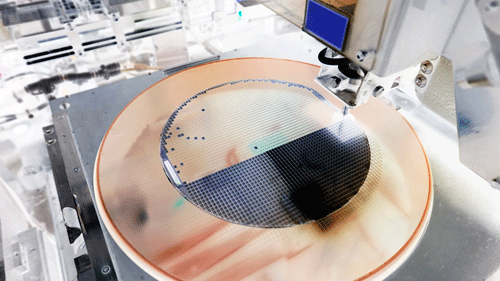
Semiconductor manufacturing is part of the global multibillion-dollar semiconductor industry. This sector of manufacturing produces semiconductor devices through processing steps such as photolithography, etching and deposition, among others. Production yield, which is impacted most by equipment uptime and product quality, stands as one of key performance indicators for manufacturers. There is, therefore, an understandable focus on monitoring the condition and process performance of high-priced equipment, such as lithography equipment, which can cost 100 million dollars or more. While these machines are critical and expensive to maintain, it is important to also acknowledge the key role pumps play in the semiconductor manufacturing facility and thereby the large negative impact their failure can have on a company’s productivity, resources and finances.
Turbomolecular (turbo) pumps and cryogenic pumps are critical semiconductor processing equipment for a clean room. Dry vacuum pumps, among other systems, make up the sub-fab, which provides vacuum and abatement systems to support the main processing equipment on the above floor in the clean room. It is common in semiconductor fabrication plants (fabs) to have thousands of dry vacuum pumps, as well as hundreds or even thousands of turbo pumps.
Due to the sheer number of pumps used in this manufacturing operation, maintaining their condition is a challenging task. A semiconductor facility typically operates 24 hours a day, seven days a week. Therefore, a dry pump issue would lead to overall equipment failure, resulting in wafer production downtime.
It is not uncommon for an hour of unplanned downtime to cost the fab hundreds of thousands of dollars.1 Although there are efforts in place for pump condition monitoring in semiconductor manufacturing, in many cases, run-to-failure and reactive maintenance are common strategies used for the thousands of pumps in industry fabs, leaving room for unexpected failures.
This highlights the potential of leveraging advancements in sensing and analytics to apply condition monitoring technology for pumps used in semiconductor manufacturing for a more predictive and proactive approach.
Semiconductor Pump Failure Modes & Key Signals
Common failure modes for dry vacuum pumps used in the sub-fab include sudden deposit ingestion, exhaust pressure blockages, pump seizures caused by deposition and the degradation of pump components resulting in excessive performance loss.2 Amps increase and decrease flow within pumps. The amp current draw is the most common signal for monitoring dry vacuum pumps. Other signals used for monitoring include vibration, gas flow and pressure. It is
also common to collect additional context data related to the pump speed (rotations per minute [rpm]), as well as other process and recipe information.
In comparison to dry vacuum pumps, turbo pumps operate at fast rpm, such as 30,000 rpm, and have a different set of failure modes. The failure modes for the turbo pump include motor failure, bearing failure and broken or bent blades on the rotor assembly.
The bearings and motor can be replaced, but a damaged rotor would likely require a replacement of the entire pump. These failures for the turbo pump cause higher current draw, more frequent vibration, abnormal sounds and higher temperature; thus, measuring vibration, current and temperature is common.
Condition Monitoring Challenges for Semiconductor Pump Applications
One key challenge with predictive monitoring for semiconductor pump applications is establishing the data collection system to monitor various sub-fab and clean room pumps, including dry vacuum pumps, turbo pumps and cryogenic pumps, among others. This system requires the appropriate sensors, infrastructure and protocols to not only capture current, pressure, flow rate, temperature and vibration signals, but also to integrate this data collection into the existing data collection structure for other clean room processing equipment involved in etching, deposition, lithography and more. This integration is needed as the context information regarding process and recipe data supports the proper analysis of the pump condition monitoring data and allows for a more accurate assessment of the pump’s health condition.
Another central challenge involves the proper analysis of pump data. This is due to the overall complexity of the process and the variety of different signals that are analyzed together, such as pressure, flow rate, current, vibration and temperature. Although there is existing work on the use of statistical methods and machine learning methods for pump monitoring in semiconductor applications, this research is less established than that of centrifugal and other pump types used in different industries.
Recommended Path Forward
There are still many unmet challenges that need to be resolved in order to achieve widespread adoption of predictive monitoring in this industry. One recommended path forward to ensure semiconductor fabs achieve universal implementation is as follows:
With contributions from fabs/end-users, pump OEMs and tool/equipment makers, formulate a list of key required signals for each pump type.
Industry and standards organizations should work together to establish an agreed upon data collection strategy, which includes communication protocols, sampling rates and ways data can be integrated into other semiconductor manufacturing and equipment data collection systems.
Through industry consortiums and independently funded pilots, develop and validate pump condition monitoring algorithms using various statistical and/or machine learning methods.
When feasible, establish a set of reference or benchmark data sets to support the research and development of more robust condition monitoring algorithms for semiconductor pump applications.
Develop a road map for scaling the solution to thousands of pumps, including defining the roles of the pump OEMs, fabs/end-users, tool/equipment makers and technology providers.
References
atlascopcogroup.com/en/innovation/innovation-stories/2016/pumping-for-semiconductor-success
core.ac.uk/download/pdf/297011834.pdf


